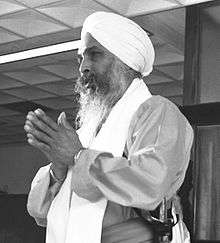Ardās

| Part of a series on |
| Sikh practices and discipline |
|---|
The Ardās (Punjabi: ਅਰਦਾਸ) is a Sikh prayer that is done before performing or after undertaking any significant task; after reciting the morning and evening Banis (prayers),[1][2] at the completion of a service like the Paath (scripture reading/recitation),[3] kirtan (hymn-singing) program or any other religious program.[4] In Sikhism, Ardās may also be said before and after eating. The prayer is a supplication to God to support and help the devotee with whatever he or she is about to undertake or has done.
Structure
The Ardās is usually always done standing up with folded hands and is commonly preceded by the eighth stanza of the fourth ashtapadi of the bani Sukhmani, beginning Tu Thakur Tum Peh Ardaas. The beginning of the Ardās is strictly set by the tenth Sikh Guru, Guru Gobind Singh and may not be altered or omitted. It appears as the opening passage of Var Sri Bhagauti Ji Ki (see Chandi di Var) and is an invocation to God and reminder of the Sikh Gurus.
What follows is several paragraphs recounting significant events in Sikh history and gratidute for blessings. This may be omitted if reciting a "short ardaas".
Towards the end the devotee can say a personal prayer such as "Waheguru please bless me in the task that I am about to undertake" when starting a new task or "Akal Purakh, having completed the hymn-singing, we ask for your continued blessings so that we can continue with your memory and remember you at all times", etc.
The end of the Ardaas (Nanak Nam Chardi Kala, Tere Bhane Sarbat Da Bala, "O Nanak, may the Nam (Holy) be ever in ascendance! in Thy will may the good of all prevail!") is also set and may not be altered or omitted.[5]
Origins
The word "Ardās" is derived from Persian word 'Arazdashat', meaning a request, supplication, prayer, petition or an address to a superior authority.
Ardās is a unique prayer based on the fact that it is one of the few well-known prayers in the Sikh religion that was not written in its entirety by the Gurus. The Ardās cannot be found within the pages of the Guru Granth Sahib because it is a continually changing devotional text that has evolved over time in order for it to encompass the feats, accomplishments, and feelings of all generations of Sikhs within its lines. Taking the various derivation of the word Ardās into account, the basic purpose of this prayer is an appeal to Waheguru for his protection and care, as well as being a plea for the welfare and prosperity of all mankind, and a means for the Sikhs to thank Waheguru for all that He has done.
Meaning
The Ardās is said as a reflection on everything it took for the Divine to create the pure Shabad Guru on earth and to remember all that the Sikh endured to protect it and ensure it landed in the hands of the future generation. It encompasses many Sikh and Humanistic values, such as peace and understanding, as well as faith and perseverance. Ardas is a unique Sikh prayer that was not written by the Gurus and cannot be found in the Guru Granth Sahib Ji (the holy book of the Sikhs). Ardas is known to be changing and evolving prayer which is recited by an individual in accordance to his/her feelings, accomplishments and state of mind. Therefore, the purpose of this prayer is to appeal to Waheguru (the supreme being) for protection, care and welfare of the mankind, while thanking Him for everything he has provided us with. Ardas reflects upon Guru given Gurbani (prayers), appreciates the Sikh martyrs, preserves Humanistic values and peace, and cultivates faith. Ardas also provokes positive human emotions such as Nimrata (Humility), Daya (Compassion), Chardi Kala (fearlessness; in high spiritual state of mind). It encourages one to become a better Sikh and also a better human being by linking the minds to those of the “pure and brave ones” from history. A sense of community and the betterment of the society (sarbat da bhala) are the key components of Ardas. Ardas is divided into three sections. First section remembers all the ten gurus and their legacies to the Sikh religion. Second section discusses the sacrifices made by brave and spiritual leaders of the Sikh History and conspires a Sikh to be like them and protect others from the unjust world and oneself from worldly vices. The third section allows a Sikh to appeal for any specific wants/needs and for any sort of forgiveness and further guidance. Like mentioned before, this prayer ends with the ultimate appeal for the prosperity of the humanity.
Ardas Link
Audio
- Sant Singh Maskeen - Ardas
- Pinderpal Singh (Ludhiane Wale) - Ardaas
- 50 Glorious Years of Recorded Shabads Volume V: 11 - 50 GYORS - Ardas - Tarlochan Singh
See also
External links
Notes
References
- Sikh Rehat Maryada: The code of Sikh conduct & conventions, Dharam Parchar Committee (Shiromani Gurdwara Parbandakh Committee) n.d., Amritsar.
- MacAuliffe, M A 1909, The Sikh religion: its gurus, sacred writings and authors, The Clarendon Press, Oxford.